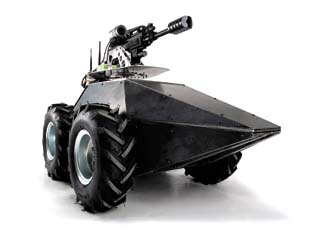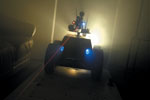Robots Arming for Combat Duty
 |
Developed by Inspector Bots, the Mega Hurtz prototype can be armed with a variety of nonlethal weapons. |
Unmanned ground systems on the battlefield provide critical intelligence, surveillance and reconnaissance data and help counter improvised explosive devices. Now, ground robots are positioned to expand into armed missions in Afghanistan.
Three U.S. Army units—two active duty and one National Guard—are preparing to go to war with robots armed, for now, with nonlethal weapons for force protection at fixed locations, such as garrisons and combat outposts. The Army and Marines also are hammering out the tactics, techniques and procedures for using armed robots. Additionally, the Army expects later this year to finish the requirements document for the Multi-Mission Unmanned Ground System, which will include an armed version capable of deploying with small tactical units, possibly as early as 2013.
The requirements document for the Multi-Mission Unmanned Ground System will include two variants—one that will perform the traditional mission of countering improvised explosive devices and an armed version designed to go on maneuvers with small tactical units, according to Don Sando, director of capabilities development and integration for the Army’s Maneuver Center of Excellence, Fort Benning, Georgia. The Maneuver Center of Excellence was formed when the Army consolidated its infantry and armor schools, and it is now the Training and Doctrine Command proponent for tactical unit unmanned ground system requirements.
“For the small tactical unit, the employment of armed robotic systems could potentially provide a couple of advantages—to extend the battlefield to a certain degree and to provide supporting fire that currently has to be provided by soldiers who may or may not have to be exposed to do that,” Sando says. “To extend the battlespace, we intend to arm those systems with weapons that are currently with our units—light or medium machine guns or light or medium anti-tank weapon systems. So the armed robot could extend the flanks or could be put out in front of the unit to a certain degree to allow the robots to see and engage targets beyond where soldiers might be deployed.”
Sando projects that the requirement document will be done by the end of summer, and it could be available in 2013.
However, fixed-site protection likely will be the primary mission for armed robotic systems in the short term, according to industry sources. “What we’re seeing is a uniform position coming forward from multiple parts of the military for an integrated base and defense security application of the system. It has to be integrated with other sensor suites rather than being a stand-alone system,” says Bob Quinn, vice president of Talon operations, QinetiQ North America, which produces the Modular Advanced Armed Robotic System (MAARS). This system uses a range of nonlethal weapons, including a laser to dazzle and confuse an enemy temporarily, as well as bean bags, smoke and pepper spray. It also can pack 40-millimeter, high-explosive grenades or an M240B medium machine gun firing 7.62-millimeter ammunition.
“There are three different Army units scheduled to go forward into Afghanistan later this calendar year. All three have indicated to us that they are preparing the requirements documents for the system,” Quinn says. “What is consistent with all three, though, is that it’s all the same mission—it’s not for breaking down doors in an offensive measure, but rather for an integrated base defense security measure, as a defensive capability adding to the existing suite at these garrisons and combat outposts.”
Initial systems, however, have not been cleared to use the M240B or high-explosive grenades, but five types of nonlethal grenades are an option. “Army Test Center, Aberdeen, Maryland, does an exhaustive analysis to assure the system is safe for soldiers to use in the field. The Army Test Center has provided multiple limited safety releases for soldiers to use the MAARS system up to the point of firing live rounds of ammunition,” Quinn reveals.
 |
The Mega Hurtz unmanned ground vehicle prototype uses a laser to find its target. |
While weaponized robots will be paired with other sensors in their site-protection role, they will be teamed with combat soldiers in their missions to extend the battlefield and provide supporting fire. The systems are not designed to act alone. “We cannot leave it unattended—just like a soldier on the battlefield. You can’t leave him unattended, either. You have to cover him, protect him,” Sando says. “The robot is part of a team, in this case part of a manned-unmanned teaming system, so the extent [to which] you can deploy it and have it operate autonomously is quite limited.”
That limitation exists because unmanned ground systems are surprisingly easy to counter when left alone, according to Sando and others. Soldiers experimenting with and evaluating them quickly learned they can sneak up behind the unmanned systems and either flip them over or throw a blanket over them, rendering their cameras useless, reports Brig. Gen. Tom Fields, USA (Ret.), senior associate with Burdeshaw Associates Limited, a Bethesda, Maryland, consulting company. Also, adding weapons makes the systems more top-heavy and more vulnerable to turning over, whether on tough terrain or at the hands of enemy troops. Including more sensors so that the systems have a 360-degree line of sight adds expense in tough budgetary times. The robot’s communications also can be jammed, causing soldiers to lose control of the system.
Still, Gen. Fields says, weaponized ground drones likely will find a place on the battlefield. “I believe there is a future for armed robotics. I don’t think you’re going to see platoons or companies of armed robots and people sitting back in air-conditioned vans controlling them, but I think you will see specialized use of them for point security at critical sites and that sort of thing. It’s just a matter of getting over the mobility and control issues and engaging the cost issues,” the general says.
Despite the limitations and the missions currently being planned, it remains to be seen what effect armed robots might have on the battlefield or how they will be used, Sando observes. “We can have good ideas about how we envision the deployment of any particular system, and then we give it to the soldiers during the experimentation and evaluation process, and they can come up with very creative and innovative ways to use it,” he observes. “So, we’re always looking not only at how we might take a current battlefield task and have it performed better or more efficiently, but also how that robotic system might actually change what I have to do on the battlefield.”
During experimental exercises, for example, soldiers quickly learned that the presence of a drone, whether air or ground, will tip off enemy forces to the presence of U.S. troops. In response, friendly forces began conducting feints by deploying a robot on one side of a village to capture enemy attention and attacking on the village’s other side. “I think the possibilities are almost limitless. In my view, certainly within the next few years, I think you’ll see a tremendous proliferation of robotic systems, even more so than what we’ve seen over the last nine years or so of the war,” Sando says.
The military never has fielded an armed ground robotic system program of record, but non-program-of-record systems have been deployed in limited numbers to the war theater for experiments or evaluations. In 2005, for example, Army Special Operations units experimented with the prototypical predecessor to MAARS known as the Special Weapons Observation Reconnaissance Detection System (SWORDS). According to Quinn, the systems were sent back for lack of an Army safety release document. SWORDS deployed to Baghdad a few years later with the 3rd Brigade, 3rd Infantry Division. “The three systems that the 3rd Infantry Division used were rotated to the next unit, and they were not pulled from theater. They saved lives. They did what they were supposed to do,” Quinn reports.
SWORDS was developed by Foster-Miller, which subsequently was purchased by QinetiQ along with a range of other companies, and QinetiQ was renamed QinetiQ North America. The company took the lessons learned from SWORDS and incorporated them into MAARS, which replaced the discontinued SWORDS system. Improvements include an icon indicating which way the weapon system is pointed to prevent any confusion during the chaos of combat. For added safety, it has a lockout switch to prevent shooting in the direction of the operator unless the lockout feature is overridden. The system also now includes the FalconView mapping application overlaid with friendly force tracking icons so the operator knows the location of other forces. The robot even has an icon of its own so that others are aware of its presence on the battlefield. Additionally, it comes with a 10-pound controller instead of the original 50-pound suitcase. The slew rate is faster, and the center of gravity is lower for more stability.
According to information provided by Federal Sources Incorporated, a government market intelligence provider in McLean, Virginia, all of the current funding for armed robots is for research, indicating that it is an emerging market but with work still to be done. It is a market that some companies are eager to break into while others take a wait-and-see approach.
Chris Rogers, inventor and founder of Inspector Bots, recently released the Mega Hurtz tactical robotic platform for the military and law enforcement agencies. It is a full-scale, proof-of-concept, working prototype. Mega Hurtz is armed with nonlethal capabilities. It comes equipped with a reconfigurable, 20-rounds-per-second, nonlethal, military-style .68-caliber paint gun mounted to a 360-degree turret. It can fire rubber rounds, hard nylon rounds, pepper balls, paintballs or frangible rounds, which break apart on impact. The hard nylon rounds are useful for breaking windows; the paintballs are for marking a suspect in a crowd, Rogers explains. In fact, the suspect can be marked with an infrared round visible only with infrared cameras.
“I’ve had interest from all over the world, including Singapore, India, Italy, France, Mexico, the United Kingdom, Israel, Jordan, Australia and Brazil, among others,” Rogers says. “Domestically, I have been in touch with the North Metro Denver SWAT team, the Colorado Special Operations Unit, the joint nonlethal weapons group for the Air Force and the Marine Corps and a supplier for the Defense Department and the intelligence community. I think I will start selling the new Mega Hurtz robot very soon.”
Officials at iRobot, on the other hand, do not yet see a demand for armed robots, and the company thus far has not developed one, reveals Robert Moses, president of iRobot’s government and industrial robot division. “Current Army doctrine does not have armed robots. Do we expect that to happen sometime? Perhaps. And we want to go ahead and be in position to do that, but right now, we are not pursuing that,” Moses says.
WEB RESOURCES
Army Maneuver Center of Excellence: www.benning.army.mil/
Inspector Bots: www.inspectorbots.com/_Home.html
MAARS: www.qinetiq-na.com/products-maars.htm
| At a Glance No armed ground robotic systems currently are deployed. More than 5,000 unmanned ground systems have been deployed to Iraq and Afghanistan. Currently, more than 2,000 ground robots are fielded in Afghanistan and more than 700 in Iraq. Fielded systems include the Talon, PackBot, Multi-function Agile Remote Control Robot (MARCbot), the Mini-Explosive Ordnance Disposal (Mini-EOD) and the M160 six-ton area flail system. |




Comments